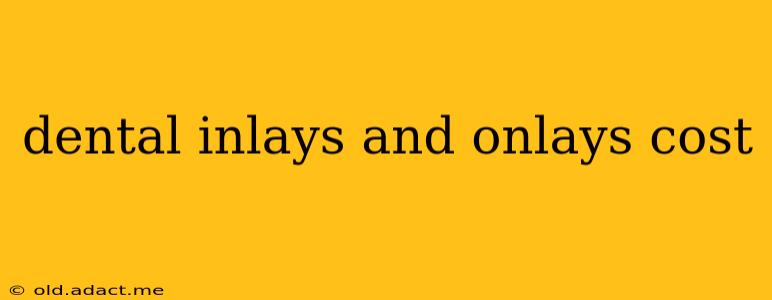Dental inlays and onlays are restorative treatments used to repair damaged teeth, offering a less invasive alternative to crowns in many cases. Understanding the cost of these procedures is crucial for budgeting and planning your dental care. This guide will break down the factors influencing the price of inlays and onlays, helping you navigate the financial aspects of this important dental work.
What are Dental Inlays and Onlays?
Before diving into the cost, let's clarify what inlays and onlays are. Both are indirect restorations, meaning they're created in a dental lab and then cemented onto the tooth. They're made from durable materials like porcelain, gold, or composite resin.
-
Inlays: These restorations fill in the tooth's chewing surface, similar to a filling, but are custom-made for a more precise fit. They're ideal for repairing smaller cavities that don't involve the tooth's cusps (the pointed projections on the chewing surface).
-
Onlays: These cover one or more cusps of the tooth, offering more extensive protection than inlays. They're suitable for larger cavities that affect the cusps but don't require a full crown.
How Much Do Dental Inlays and Onlays Cost?
The cost of dental inlays and onlays is highly variable and depends on several factors:
-
Material: Porcelain inlays and onlays are generally the most expensive, followed by gold, and then composite resin. Porcelain offers excellent aesthetics and durability, while gold is exceptionally strong and long-lasting. Composite resin is more affordable but may not last as long.
-
Location: Geographic location significantly impacts pricing. Dental costs vary considerably between states and even within cities. Urban areas often have higher costs compared to rural areas.
-
Dentist's Fees: Each dentist sets their own fees, which can reflect their experience, expertise, and overhead costs. A specialist, such as a prosthodontist, might charge more than a general dentist.
-
Number of Teeth Treated: The cost will increase proportionally with the number of teeth requiring inlays or onlays.
-
Insurance Coverage: Dental insurance plans vary greatly. Some may cover a portion of the cost, while others offer minimal or no coverage. It's crucial to check your policy's specifics regarding inlays and onlays. Pre-authorization might also be required.
What Factors Influence the Cost of Dental Inlays and Onlays?
This section addresses some common questions surrounding the cost of inlays and onlays:
What is the average cost of a dental inlay or onlay?
There's no single "average" cost. Estimates range from a few hundred dollars to over a thousand dollars per tooth. The wide range reflects the varying factors mentioned above. It's best to obtain a personalized quote from your dentist after a thorough examination.
Are dental inlays and onlays covered by insurance?
Coverage depends entirely on your specific dental insurance plan. Some plans cover a percentage of the cost, while others may not cover them at all. Contact your insurance provider to understand your coverage before proceeding with treatment.
How long do dental inlays and onlays last?
With proper oral hygiene and regular dental checkups, inlays and onlays can last for many years, sometimes a decade or more. However, their lifespan depends on factors like the material used, the patient's oral hygiene practices, and the extent of the damage being repaired.
What are the alternatives to dental inlays and onlays?
Alternatives include dental fillings (for smaller cavities), crowns (for more extensive damage), or, in some cases, tooth extraction followed by dental implants. The most appropriate treatment option depends on the individual's needs and the extent of the tooth damage.
How can I save money on dental inlays and onlays?
- Shop Around: Get quotes from multiple dentists to compare pricing and services.
- Check for Payment Plans: Many dental offices offer payment plans to make treatment more affordable.
- Inquire about Discounts: Some dentists may offer discounts for cash payments or prompt payment.
- Maximize Insurance Coverage: Understand your insurance benefits fully and ensure pre-authorization when necessary.
Ultimately, the cost of dental inlays and onlays is a personalized matter. A thorough consultation with your dentist is essential to understand the specific costs involved in your case, along with the overall treatment plan. This will enable you to make informed decisions about your oral health and budget accordingly. Remember to always ask questions and clarify any uncertainties before committing to any dental procedure.
